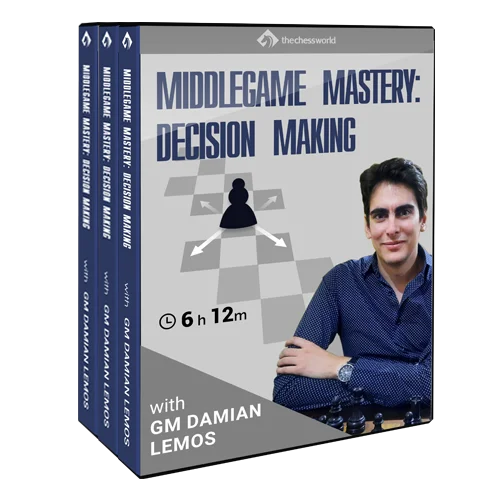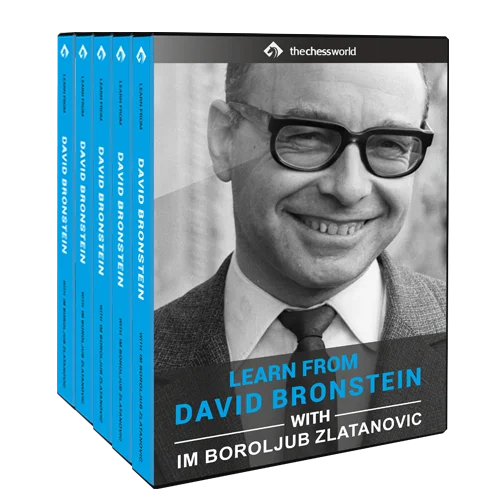IM Boroljub Zlatanovic deep dives into some of the most instructive Mikhail Tal's games and explains the most effective techniques Tal used to destroy his competition.
Imagine you’re playing a big game…
And instead of playing it safe, and being afraid to make a slight mistake…
You go with an all-out attack. Buldozering your way to the opponent’s King.
With zero doubt, you finally secure the win.
This is Mikhail Tal’s playing style, my friend.
His moves weren’t always textbook perfect, but practically no one can prove it over the board.
Want to learn to play like this?
IM Boroljub Zlatanovic deep dives into some of the most instructive Mikhail Tal’s games and explains the most effective techniques Tal used to destroy his competition.
For Tal, chess was a precise science, with success hinging on the perfect mix of elements. IM Zlatanovic takes a step-by-step approach, covering everything from Tal’s Attacking Recipe to Strategic Play and Opening Ideas.
Here’s what you are going to learn:
- Passed Pawn in the Opening (??) – You create a passed pawn on move 7. You get it to the 3rd rank to fuel a vicious attack. A few moves and one sac later, White resigns. Want to learn to do it? Check Chapter 9 on Initiative.
- Shocking Sac & Mate – You make a bold, seemingly unsound sacrifice that throws your opponent off balance. Then, you watch their position collapse like dominos just a few moves later. You’ll master this technique in Chapter 17.
- Tal’s Attacking Recipe – You open up the h-file. Line up both of your bishops. Play a typical rook sac. The rest is automatic. You unleash the monstrous power of the light-squared bishop to finish off the game. Learn this common theme in Chapter 21.
- Strategic Play 2.0 – You regroup your pieces. Do a series of equal-looking exchanges. And all of a sudden you have a rook on the open file and a knight in the center. And this all happens flawlessly, without much effort. Black is completely outplayed. See Chapter 35.
Those are just a couple of examples of typical attacking themes you’re about to learn.
Add just ONE of these themes to your game, and it could result in 20-30 Elo gains!
And this course covers 28 of those!
Outline:
Introduction
Chapter 1. Sicilian Battles. Tal – Polugaevsky
Chapter 2. Sicilian Battles. Tal – Taimanov (1962)
Chapter 3. Sicilian Battles. Tal – Bolbochan
Chapter 4. Sicilian Battles. Tal – Taimanov (1966)
Chapter 5. Benoni & Kings Indian Battles. Geller – Tal
Chapter 6. Benoni & Kings Indian Battles. Prieditis – Tal
Chapter 7. Benoni & Kings Indian Battles. Donner – Tal
Chapter 8. Benoni & Kings Indian Battles. Timman – Tal
Chapter 9. Initiative. Saigin – Tal
Chapter 10. Initiative. Tal – Larsen
Chapter 11. Initiative. Tal – Simagin
Chapter 12. Initiative. Tal – Smyslov
Chapter 13. Initiative. Tal – Keller
Chapter 14. Creativity. Thorbergsson – Tal
Chapter 15. Creativity. Tal – Vasiukov
Chapter 16. Creativity. Tal – Botvinnik
Chapter 17. Creativity. Tal – Koblencs
Chapter 18. Creativity. Tal – Hecht
Chapter 19. Attack on King. Tal – Mohrlok
Chapter 20. Attack on King. Tal – Olafsson
Chapter 21. Attack on King. Tal – Gurgenidze
Chapter 22. Attack on King. Gurgenidze – Tal
Chapter 23. Attack on King. Tal – Myagmarsuren
Chapter 24. Strategy. Tal – Najdorf
Chapter 25. Strategy. Tal – Kochyev
Chapter 26. Strategy. Novopashin – Tal
Chapter 27. Strategy. Tal – Saidy
Chapter 28. Strategy. Tal – Matanovic
About the Author:
IM Boroljub Zlatanovic [2438 FIDE]
is an International Master and a professional chess coach from Serbia. He has been coaching chess for over 15 years and his students showed outstanding results in the Youth and Junior Championships. You are at the right place with IM Zlatanovic whether you want to improve: your endgame (basic, typical, complex), middlegame (global strategy, tactics, and typical positions) or expand and deepen the opening repertoire.












